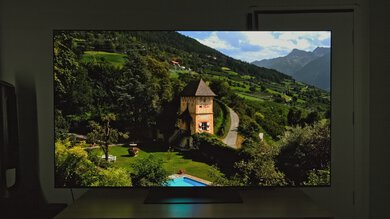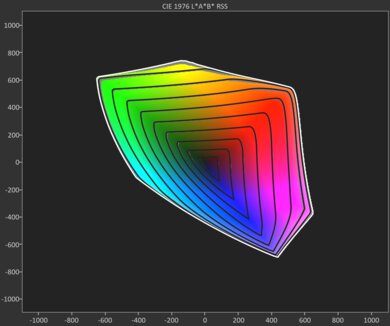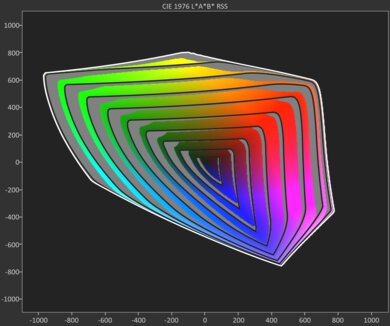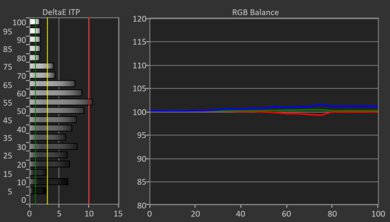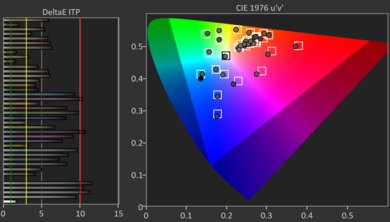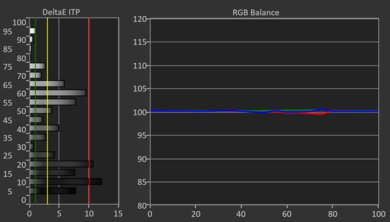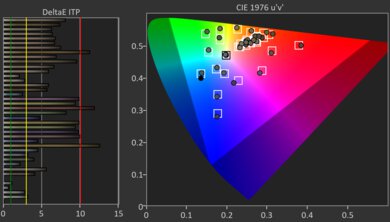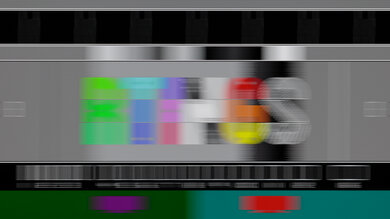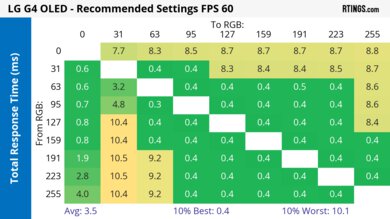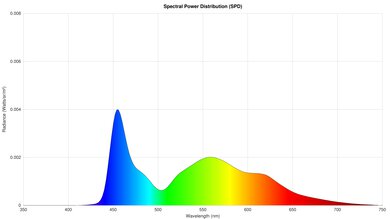The LG G4 OLED is LG's flagship 4k TV for 2024. It replaces the LG G3 OLED and sits above the LG C4 OLED. Like its predecessor, it uses Micro Lens Array (MLA) technology for better brightness than typical WOLED panels, but unlike the G3, the G4's 83-inch model also includes MLA, although the super expensive 97-inch model doesn't. It uses the 2024 version of LG's webOS, and the TV has 60W 4.2 channel speakers built-in that can be virtually up-mixed to 11.1.2 using the α11 AI Sound Pro feature. We bought and tested the 65-inch model, but it's available in five sizes: 55, 65, 77, 83, and a massive 97-inch model. Unlike its predecessor, the 55-inch and 65-inch models now include a stand in North America, but the 77-inch, 83-inch, and 97-inch models still come with LG's Slim Wall Mount.
Our Verdict
The LG G4 is excellent for mixed usage. You get a top-notch gaming TV that's loaded with modern features and delivers clear motion, so it's a great choice to pair with modern consoles and PCs. You also get an amazing home theater TV that's sure to impress with both SDR and HDR content, and it's one of the few OLEDs on the market with the reflection handling and brightness needed to fight glare in a well-lit room. Furthermore, it has an incredibly wide viewing angle, so it's a great TV when you have friends over to watch sports.
Near-infinite contrast ratio for perfect blacks with no blooming around bright highlights.
- Incredibly wide viewing angle for a consistent image from the sides.
Good SDR brightness and excellent reflection handling makes it suitable for a bright room.
Colors are vibrant, lifelike, bright, and accurate.
The LG G4 is amazing for a home theater. It has perfect black levels, so blacks are inky with no blooming whatsoever. It has excellent HDR peak brightness, so highlights really stand out in HDR movies and shows. You also get vibrant and lifelike colors in both SDR and HDR, and colors are very accurate overall. The TV has great image processing that gives you a clean-looking image for times you're stuck watching low-quality and low-resolution content, and HDR content has minimal banding and accurate brightness. Unfortunately, due to the TV's nearly instantaneous response time, there's noticeable stutter in movies and TV shows.
Near-infinite contrast ratio for perfect blacks with no blooming around bright highlights.
Colors are vibrant, lifelike, bright, and accurate.
Excellent HDR peak brightness that makes highlights pop.
Does an excellent job upscaling and cleaning up low-quality content.
- Noticeable stutter due to the TV's fast response time.
The LG G4 is good for use in a bright room. It has good SDR brightness, especially for an OLED, so it's bright enough for use in a well-lit room. It also does a great job reducing the intensity of direct reflections like a lamp placed opposite the screen, so you aren't distracted by pesky light sources. You do lose those inky black levels OLEDs are known for when you use the TV in a bright room, but they still remain deep enough that the image doesn't look washed out. Unfortunately, colors don't look nearly as vibrant as they do when using the TV in a dark room.
Good SDR brightness and excellent reflection handling makes it suitable for a bright room.
Ambient light causes colors to lose vibrancy.
The LG G4 is very good for watching sports. Its incredibly wide viewing angle makes it suitable for watching the game with friends, as anyone sitting to the sides of the screen sees a consistent image. The TV has the brightness and reflection handling needed to overcome glare, so it's suitable for Sunday afternoon NFL games. You also won't be distracted by the dirty screen effect when watching sports with large areas of uniform color, so you can stay immersed in the big game. It also does a solid job upscaling and removing artifacts from low-quality content, so you get a clean-looking image. Furthermore, there's no noticeable blur behind quick-moving players and objects due to the TV's nearly instantaneous response time.
- Incredibly wide viewing angle for a consistent image from the sides.
Good SDR brightness and excellent reflection handling makes it suitable for a bright room.
Colors are vibrant, lifelike, bright, and accurate.
Does an excellent job upscaling and cleaning up low-quality content.
Ambient light causes colors to lose vibrancy.
The LG G4 is amazing for playing video games. It has an almost instantaneous response time and the low input lag needed for a responsive gaming experience experience, and you get VRR for a nearly tear-free image. Colors are well saturated and vibrant on this TV, so colors in your favorite games really pop out. It also has excellent HDR brightness, so highlights in HDR games really stand out against the rest of the image. Enabling Game Optimizer doesn't majorly impact image quality, so you don't have to worry about trading picture quality for the best performance. The TV has HDMI 2.1 bandwidth on all four ports for up to 4k @ 144Hz, making it an excellent TV to pair with modern consoles and gaming PCs.
Incredibly low input lag for a very responsive experience.
- Nearly instantaneous response time for no noticeable blur behind fast motion.
Colors are vibrant, lifelike, bright, and accurate.
Excellent HDR peak brightness that makes highlights pop.
The LG G4 has impressive brightness overall. It's one of the few OLEDs with the SDR brightness needed to overcome glare in a well-lit room, and its excellent HDR brightness means highlights in HDR content are impactful.
Good SDR brightness and excellent reflection handling makes it suitable for a bright room.
Excellent HDR peak brightness that makes highlights pop.
Being that the LG G4 is an OLED, it has outstanding black levels. Blacks are deep and inky when viewed in a dark room, with no blooming around bright highlights.
Near-infinite contrast ratio for perfect blacks with no blooming around bright highlights.
The LG G4 has great colors overall. It has the color volume in both SDR and HDR needed for a vibrant viewing experience. Additionally, colors are very accurate across the board, so even most color purists will be satisfied without needing a professional calibration.
Colors are vibrant, lifelike, bright, and accurate.
Note: We're in the process of improving our tests related to image processing, but this score should give you a general idea of how a TV performs overall with its image processing capabilities.
The LG G4 OLED has impressive image processing all around. It has excellent upscaling and low-quality content smoothing, which really helps to give you a clean looking image with SD and HD content. You also get minimal banding in color gradients, and the brightness of HDR content is very accurate.
Does an excellent job upscaling and cleaning up low-quality content.
The LG G4 has outstanding responsiveness while using the Game Optimizer. It delivers crisp motion due to its almost instant pixel transitions, gaming feels responsive thanks to its incredibly low input lag, and it supports all three commonly used VRR formats.
Incredibly low input lag for a very responsive experience.
- Nearly instantaneous response time for no noticeable blur behind fast motion.
We're in the process of fixing the way we evaluate a TV's overall motion handling. This section is currently broken, and the score isn't indicative of how well a TV handles motion overall.
Performance Usages
Changelog
- Updated May 08, 2025: Converted to Test Bench 2.0.1. We did this to fix an issue with our scoring in the Supported Resolutions section, since TVs with a refresh rate higher than 144Hz were being penalized for not supporting 144Hz.
-
Updated May 07, 2025:
Mentioned the newly reviewed LG G5 OLED in the SDR Brightness section.
-
Updated Mar 26, 2025:
We wrote text for the new tests and rewrote text throughout the review after updating pre-existing tests and scores for Test Bench 2.0.
- Updated Mar 26, 2025: We converted the review to Test Bench 2.0. With this new methodology, we've added new tests to expand the scope of our testing, adjusted our scoring to better align with current market conditions, and added performance usages that group related tests together to give more insight into specific aspects of a TV's performance. You can find a full list of changes in the TV 2.0 changelog.
Check Price
Differences Between Sizes And Variants
We bought and tested the 65-inch LG G4 OLED (OLED65G4SUB), but our results are also valid for the 55, 77, and 83-inch models. The massive 97-inch model doesn't have the MLA focusing layer, so it isn't as bright as the smaller models. Note that the last three letters in the model number (SUB and WUA in this case) vary between retailers and individual regions, but there's no difference in performance. In the UK, you can also get the 55-inch and 65-inch models with a wall mount (LW) instead of a stand (LS).
| Size | US Model | UK Model | Stand or Wall Mount | MLA |
|---|---|---|---|---|
| 55" | OLED55G4SUB | OLED55G46LS | Stand | Yes |
| 65" | OLED65G4SUB | OLED65G46LS | Stand | Yes |
| 77" | OLED77G4WUA | OLED77G45LW | Slim Wall Mount | Yes |
| 83" | OLED83G4WUA | OLED83G45LW | Slim Wall Mount | Yes |
| 97" | OLED97G4WUA | OLED97G45LW | Slim Wall Mount | No |
Our unit was manufactured in March 2024, as seen on the label.
Popular TV Comparisons
The LG G4 OLED is an incredible TV and one of the best OLEDs on the market. It has very few direct competitors but shares a similar panel and overall performance to the Panasonic Z95A OLED. It's brighter overall than the 2023 LG G3 OLED, increases the maximum refresh rate from 120Hz to 144Hz, and has less banding. Unfortunately, it's also very expensive. If you want similar performance overall but don't need the extra brightness, the cheaper LG C4 OLED is a solid alternative.
For more options, check out our recommendations for the best OLED TVs, the best gaming TVs, and the best TVs for watching movies.
The LG G5 OLED is better than the LG G4 OLED due to three key differences. The G5 is brighter overall, so it's better suited for bright rooms and delivers a more impactful HDR experience. The G5 also displays brighter and more vibrant colors, giving it punchier colors overall. Finally, the G5 supports 165Hz, whereas the G4 is limited to 144Hz, making it slightly better for PC gamers with powerful rigs.
The LG G4 OLED and the LG C5 OLED are surprisingly close. The C5 gets brighter in SDR, helping it fight a bit more glare from indirect reflections, and its black levels stay deeper in a bright room. Inversely, the G4 does a better job of handling direct reflections and has better HDR brightness. The G4 also maintains its brightness while using the Game Optimizer picture mode, delivering a slightly more impactful HDR experience. Finally, the G4 supports DTS audio passthrough.
The LG G4 OLED is better than the LG C4 OLED. The G4 gets brighter overall, so it overcomes more glare in a bright room while watching SDR content, and highlights pop more in HDR content. The G4 also maintains its HDR brightness much better while in 'Game Optimizer.' On top of that, the G4 is more accurate before calibration and has less banding in colors.
The LG G4 OLED and the LG G3 OLED are very similar TVs overall, but the G4 is a bit better. The G4 gets brighter in HDR, so highlights stand out more on it, and it also maintains its brightness much better in Game Mode, so you don't have to trade in performance if you don't want a decrease in brightness. On top of that, the G4 has better HDR native gradient handling, so there is less banding in colors, and it supports 144Hz, so it's better for PC gamers looking to take advantage of their high-end graphics cards.

We buy and test dozens of TVs yearly, taking an objective, data-driven approach to deliver results you can trust. Our testing process is complex, with hundreds of individual tests that take over a week to complete. Most of our tests are done with specially designed test patterns that mimic real content, but we also use the same sources you have at home to ensure our results match the real-world experience. We use two main tools for our testing: a Colorimetry Research CR-100 colorimeter and a CR-250 spectroradiometer.
Test Results

The LG G4 OLED has excellent HDR brightness. It gets bright enough for highlights to pop and delivers an impactful HDR experience. Unfortunately, large bright scenes are significantly dimmer than smaller, specular highlights due to its aggressive Automatic Brightness Limiter (ABL).
These measurements are after calibrating the HDR white point with the following settings:
- HDR Picture Mode: Cinema
- OLED Pixel Brightness: 100
- Contrast: 100
- Auto Dynamic Contrast: Off
- Dynamic Tone Mapping: Off
- Expression Enhancer: Off
- Peak Brightness: High
There's no noticeable difference with HDR brightness when the TV is set into Game Optimizer.
These measurements are after calibrating the HDR white point with the following settings:
- HDR Picture Mode: Game Optimizer
- OLED Pixel Brightness: 100
- Contrast: 100
- Auto Dynamic Contrast: Off
- Dynamic Tone Mapping: HGiG
- Expression Enhancer: Off
- Peak Brightness: High
The LG G4 OLED has good SDR brightness, and it gets bright enough to overcome glare in a bright room. The TV's Automatic Brightness Limiter isn't aggressive in SDR, so you don't have to deal with the screen dimming considerably when large areas of brightness are present.
These measurements are after calibration with the following settings:
- Picture Mode: Dark Space, night
- OLED Pixel Light: 100
- Peak Brightness: High
- Color Temperature: Warm 50
For even better SDR brightness, consider the newer LG G5 OLED.
The LG G4 is an OLED and doesn't have a backlight, so its self-lit pixels give it the same performance as a TV with perfect local dimming and no zone transitions. We still film the zone transition video on the TV so you can see how it compares to a TV with local dimming.
The LG G4 has good SDR color volume overall. Its coverage of the DCI-P3 color space is great, but it does struggle a lot more with the wider BT.2020 space. As colors become lighter, the TV struggles, so it doesn’t display light colors as well as it does darker ones.
| Volume ΔE³ | DCI-P3 Coverage |
BT.2020 Coverage |
|---|---|---|
| L10 | 97.99% | 66.91% |
| L20 | 97.79% | 66.62% |
| L30 | 97.68% | 67.36% |
| L40 | 96.80% | 68.52% |
| L50 | 95.73% | 68.77% |
| L60 | 93.27% | 66.55% |
| L70 | 88.92% | 57.59% |
| L80 | 89.06% | 55.42% |
| L90 | 84.39% | 52.32% |
| L100 | 62.21% | 40.54% |
| Total | 91.18% | 61.27% |
The LG Evo G4 has great color volume. It displays dark, saturated colors very well, and its ability to display pure whites is unrivaled. It doesn't display other colors as brightly as it does whites, but it's still enough to display vibrant colors with impact.
With the TV set to Game Optimizer, there's no visible difference in color luminance.
The LG G4 has incredible pre-calibration accuracy. The white balance and color accuracy is superb, with no noticeable issues at all. Color temperature is only slightly warmer than our target of 6500K, and gamma is very close to our target of 2.2, with only very bright scenes being a bit too bright.
After calibration to the D65 white point, the TV has exceptional accuracy. The white balance is essentially perfect, and color accuracy is even better than before. Gamma is also nearly perfect, with all scenes being displayed properly, and the color temperature is very close to our target of 6500K.
See our full calibration settings.
The TV has excellent HDR pre-calibration accuracy. Its white balance is solid overall, but there's a bit too much blue in most grays, which makes its color temperature a little bit too cool. Colors are accurate for the most part, but there are some inaccuracies throughout, especially with some blues and reds.
The TV has superb accuracy in HDR after calibration. Most issues with white balance have been fixed, and its color temperature is now closer to the 6500K standard. Color accuracy is slightly better, but there are still some minor mapping errors throughout.
The TV has very good PQ EOTF tracking. Some shadows and mid-tones are slightly brighter than intended, but the TV tracks the curve very closely. With content mastered in 600 or 1000 nits, there's a sharp cutoff at the TV's peak brightness, but since the TV is bright enough to display content mastered at those levels, a roll-off isn't necessary. With content mastered at 4000 nits, there's a more gradual roll-off to preserve detail in very bright highlights.
The LG G4 does a great job at upscaling low-resolution content like DVDs or lower-resolution streams. Details are clear enough, but very fine details are still a bit hard to make out.
Sharpness processing was calibrated with no over-sharpening for low-resolution content, with the following settings:
- Sharpness: 12
- Super Resolution: High
The TV has great HDR native gradient handling. There's some noticeable banding in dark grays, but all other colors have minimal banding or no banding at all.
The LG G4 has exceptionally low input lag when set to Game Optimizer with 'Prevent Input Delay' set to 'Boost,' resulting in a very responsive gaming experience with very little delay. For chroma 4:4:4 to work properly, the input label must be set to 'PC,' or the '4:4:4 Passthrough' setting must be enabled.
If you're a retro gamer, you can see the input lag results in 4:3 @ 60Hz below.
- 640x480: 27.2 ms
- 800x600: 34.2 ms
- 1024x768: 26.9 ms
- 1280x960: 26.9 ms
The LG G4 supports all common formats, and it displays chroma 4:4:4 properly, which is important for clear text from a PC.
There are two settings you can use to passthrough proper chroma 4:4:4. The first is to change the input label to 'PC,' and the second is to enable the '4:4:4 Passthrough' setting in the 'HDMI Settings' menu. Both of these options work the same and lock you out from using the 'Peak Brightness,' 'Noise Reduction,' 'MPEG Noise Reduction,' 'Smooth Gradation,' and 'Real Cinema' settings.
The TV supports FreeSync and HDMI Forum VRR and is certified as G-SYNC compatible, ensuring a nearly tear-free gaming experience from any VRR-enabled source.
The TV's CAD at 60Hz is fantastic. Most transitions from one RGB level to another are nearly instantaneous, but it's slightly slower when transitioning from blacks. There's also still some noticeable persistence blur due to the nature of a 60Hz refresh rate.
The TV is fully compatible with everything the PS5 offers, like 1440p @ 120Hz and 4k @ 120Hz, as well as HDMI Forum VRR. It also supports Auto Low Latency Mode, so you don't have to worry about switching to Game Optimizer to get the lowest input lag.
The TV is fully compatible with everything the Xbox Series X|S offers, including 1440p @ 120Hz, 4k @ 120Hz, HDMI Forum VRR, FreeSync Premium Pro, and Dolby Vision gaming. It also supports Auto Low Latency Mode, so you don't have to worry about switching to Game Optimizer to get the lowest input lag.
Unfortunately, due to the nearly instantaneous pixel response time of the TV, there's stutter with low frame rate content, which is most noticeable during slow panning shots.
The TV removes judder when watching 24p movies or TV shows when the Real Cinema setting is enabled, even from sources that can only send a 60Hz signal, like a cable box. Unfortunately, movies and TV shows aren't judder-free when BFI is enabled because the BFI feature only flickers at 60Hz.
The TV has a nearly instantaneous response time, resulting in incredibly clear motion with almost no blur behind fast-moving objects. Due to the sample-and-hold nature of OLED technology, there's still some persistence blur at 60Hz, but it's not noticeable when watching movies or shows.
The LG G4 doesn't have a traditional backlight and doesn't use pulse-width modulation (PWM) to dim each pixel, but it's not completely flicker-free. There's a slight dip in brightness that corresponds to the TV's refresh rate. This is very different from the PWM flicker on TVs with LED backlights and occurs on every OLED we've tested. It's not noticeable, and most people won't be bothered by this, but it can still bother people who are extra sensitive to flicker.
The TV has an optional black frame insertion (BFI) feature that reduces the appearance of persistence blur caused by the TV's nearly instantaneous response time. It can only insert black frames at a 60Hz refresh rate.
The LG G4 has an optional motion interpolation feature to help improve the appearance of motion. It works well with slower scenes but struggles with fast-moving action, so there's noticeable haloing and artifacts present in busier scenes, especially if you use the settings too aggressively.
The LG G4 does a great job of reducing the intensity of direct reflections. Reflections from direct sources of light, such as a lamp, are dimmed considerably, so they blend in well with the rest of the image.
The LG G4 does a decent job retaining its black levels in a bright room. Blacks become more raised as the amount of light in your room increases due to its MLA layer, but they remain deep enough that they don't look too gray.
The TV has exceptional reflection handling. Its glossy screen finish significantly reduces the intensity of both direct reflections and indirect reflections. There are also no distracting artifacts caused by the TV's reflection handling.
The LG G4 has alright overall color volume in a bright room. Colors displayed at low and medium luminance levels are nice and saturated, but it does struggle a lot more with showing colors at higher levels of brightness due to its reliance on its white subpixel. However, there’s not a large difference between color volume in a dark room and a bright one, especially with high-luminance colors, so you don’t lose very much color saturation in a well-lit room.
The LG G4 TV uses a WOLED panel with a RWBG pixel structure where all four pixels are never lit at the same time. Due to its subpixel layout, it has minor issues with displaying text on Windows since ClearType isn't well optimized to non-RGB subpixel layouts, but most users won't be bothered by this.
The white subpixel does an excellent job helping the TV display bright whites, but it dilutes the color purity of greens and reds.
What really separates the TV from other WOLEDs is the use of Micro Lens Array (MLA) technology. MLA acts as a focusing layer in front of the WOLED panel, allowing it to get much brighter without the TV having to run hotter. MLA adds a slight haze to the screen, but the haze isn't noticeable at all when watching the TV. Note that the 97-inch model doesn't have MLA technology.
The TV supports the full 48Gbps bandwidth of HDMI 2.1 on all four HDMI ports. This allows you to take full advantage of multiple high-bandwidth devices, like if you own both current-gen consoles and a high-end gaming PC. Unlike the LG G3 OLED, the LG G4 doesn't support ATSC 3.0 for 4k over-the-air, as LG has dropped that feature on their 2024 models.
There have been widespread reports of black screens, lines, or fuzziness issues with the HDMI 2 port that occur when switching from the TV's native apps to a device plugged into HDMI 2. We tested for this during our initial testing phase and extensively retested the port again to see if we encountered the problem. After further testing, we didn't experience this issue, so it's not a problem that affects every unit.
The TV supports a ton of audio formats. It supports DTS audio formats, which is great if you like to watch DVDs or Blu-rays, as they often use DTS for their main audio tracks.
The LG G4 has a very sleek and modern design. It's essentially the same as last year's LG G3 OLED, with very thin bezels and a flat side profile, which means it's completely flush when wall-mounted.
Unlike the LG G3 OLED, a stand is included with the 55-inch and 65-inch models in North America, so you don't have to purchase a third-party stand if you don't plan on wall-mounting it. In some other regions, you can get the 55-inch and 65-inch models with either a stand or a wall mount.
The stand is small but made from metal, and although there's a bit of wobble when the TV is pushed on, it recovers quickly and doesn't cause any issues. The stand can be adjusted to two different positions. The low position lifts the TV about 2.28", which brings the screen very close to your table. The high position lifts the TV about 3.94", so most soundbars fit underneath without blocking the screen.
Footprint of the 65-inch stand: 19.1" x 10.4".
The back of the TV has a very clean and minimalistic look. It's made of textured metal with a metallic silver border at its edges. There are recessed cutouts in the back that can be used to funnel cables through, and those cables can be funneled through the intuitive stand for cable management. If you want to wall-mount the TV, you can still do so, but the 55-inch and 65-inch models don't come with LG's Slim Wall Mount.
The TV runs the 2024 version of LG's proprietary smart interface, webOS. The interface is fast and easy to use, and it supports user profiles, so you can customize the home page for different users. LG promises at least four years of webOS updates on their TVs, and the G4 is expected to receive webOS 25 towards the end of 2025.
Unfortunately, the TV has a couple of bugs. Sometimes, the TV doesn't properly switch out of the Game Optimizer setting, so you're locked out of settings that should be available in other picture modes. To fix this, you can turn Game Optimizer on and disable ALLM and VRR. When you do this and switch to a different picture setting, everything works as it should.
The second bug causes the occasional black screen when changing resolutions and refresh rates frequently in a short period of time. The only fix for this is to unplug and re-plug the TV in, but this is unlikely to happen with real-world usage.
There are two settings in the 'Home Settings' menu, namely the 'Home Promotion' and 'Content Recommendation' settings. These settings remove the top banner ads and suggested content from the home screen. This gives your home screen a clean look, but there's no way to remove ads from the apps page.
The LG G4 has the same Magic Remote that came with the LG G3 OLED. The remote can be used as a pointer, or you can use the traditional buttons to control the TV. The TV also supports hands-free voice control through microphones on the TV itself. You can use your voice to change inputs, open apps, search for content, and ask for the weather and time.
The LG G4 OLED TV has a good frequency response. Its sound profile is well-balanced, so dialogue is easy to understand, and unlike most TVs, it actually produces a small amount of bass. The TV doesn't get very loud, but it still sounds good near or at max volume.






